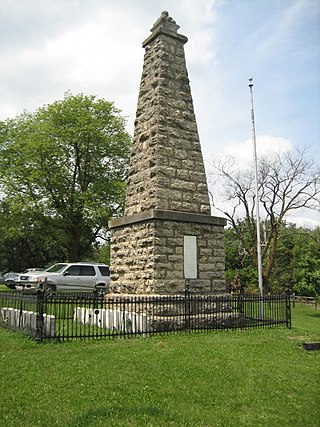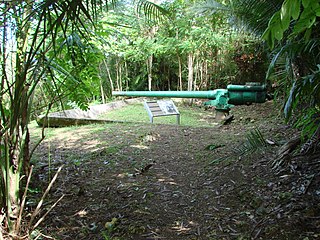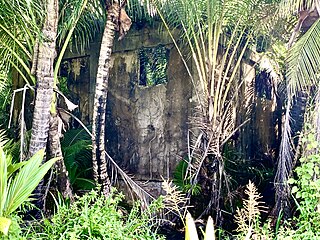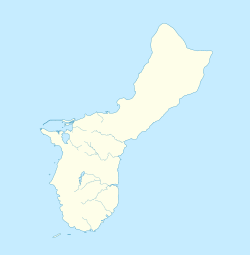
This is a list of the buildings, sites, districts, and objects listed on the National Register of Historic Places in Guam. There are currently 134 listed sites spread across 17 of the 19 villages of Guam. The villages of Agana Heights and Mongmong-Toto-Maite do not have any listings. Listed historic sites include Spanish colonial ruins, a few surviving pre-World War II ifil houses, Japanese fortifications, two massacre sites, and a historic district. Two other locations that were previously listed have been removed from the Register.

Kellogg's Grove is an area in western Stephenson County, Illinois, United States near the present-day unincorporated town of Kent. The grove is considered historically significant because it was the site of two minor skirmishes during the Black Hawk War in 1832. Today, most of the grove is privately owned but 1.5 acres (6,100 m2) are allocated as a park owned by Stephenson County. While most of the battle occurred on what is today private property the park contains a monument dedicated to the battle and cemetery with the graves of several militia members killed during the skirmish at Kellogg's Grove. The cemetery also holds the graves of those killed in other area battles. The Kellogg's Grove battle site was added to the U.S. National Register of Historic Places in 1978.

The Petagas War Memorial or Petagas War Memorial Garden is a memorial park dedicated to the Second World War victims in Sabah particularly to 324 resistance movement members, who were executed on 21 January 1944 at the site by the Japanese occupying forces of North Borneo for their involvement in the Jesselton Revolt. The park memorial plate lists the names of men of various ethnic groups in North Borneo and from various islands in the Sulu Archipelago including the main resistance leader Albert Kwok and those who assisted or died in Labuan Military Prison. The park was built exactly on the site where the massacre took place and where the victims were initially buried. It is located in Kampung Peringatan Petagas in the district of Putatan in Sabah, Malaysia.

The Piti Guns or Piti Coastal Defense Guns is the site of three Vickers-type Model 3 140-millimetre (5.5 in) coastal defense guns in the War in the Pacific National Historical Park in Piti, Guam. The Japanese manufactured these Model 3 coastal defense guns in 1914. During the Japanese Occupation of Guam from 1941 to 1944, they built up defensive positions on the island. The Chamorro population was forced to work in building up these defenses, and did so here at the Piti Guns.

The As Sombreru Pillbox I, As Sombreru Pillbox II, and As Sombreru Pillbox III are three historic defensive fortifications on Guam, near Tumon, that were listed on the U.S. National Register of Historic Places in 1991. They are pillboxes, a type of defensive fortification, built by the 48th Independent Mixed Brigade; 29th Division of the Imperial Japanese Army during 1941-1944, between Japan capturing Guam on December 8, 1941 from the United States and the U.S. recapturing Guam in 1944.

The Agana Spanish Bridge is a stone arch bridge built in 1800 in Hagåtña, Guam, during the administration of Spanish governor Manuel Muro. It is the only surviving Spanish bridge in Hagåtña, which is the capital of the United States territory of Guam. Also known as Sagon I Tolai Acho, it is located at the southwest corner of Aspenall St. and Rte. 1 and was listed on the U.S. National Register of Historic Places in 1974.
The Tinta Massacre Site, near Merizo, Guam, has significance from 1944. Also known as Tinta (66-06-1223), it was listed on the National Register of Historic Places in 1991. The listing included one contributing site and one contributing object.

The Agat World War II Amtrac is an underwater relic of World War II, located off Ga'an Point in Agat Bay on the west side of the island of Guam. It is the remains of an LVT 4, an amphibious tracked landing vehicle. It is located about 500 yards (460 m) off Agat Invasion Beach in 45 feet (14 m) of water, and was described as being in good condition when it was discovered and surveyed in 1985. These vehicles were used during the 1944 Battle of Guam, in which American forces recaptured the island from occupying Japanese forces. This particular vehicle does not appear to exhibit significant war damage. This is the most intact of the three Amtracks remaining on Guam from the 850 that participated in the battle. It was re-surveyed by maritime archaeological field schools conducted from 2009 to 2012.
The Talagi Pictograph Cave is a rock art site on the island of Guam. It is located on property owned by the government of Guam within the bounds of Andersen Air Force Base on the northern part of the island near Tarague Beach. The cave contains thirteen pictographs representing human figures, and a places where limestone mortar was used that is of prehistoric origin. Based on the characteristics of the figures, it is believed that they were probably the work of a single individual. It is one of a small number known rock art sites on the island.
The rectory on the island of Rota in the Northern Mariana Islands is a rare example of transitional Spanish-Japanese architecture in the archipelago, now a United States commonwealth. It was built about 1930, during the South Seas Mandate period of Japanese administration, when the native Chamorro people were displaced to this area by workers imported by the Japanese to work in the sugar fields. The rectory is an L-shaped concrete structure measuring 13.7 by 19.8 metres, and originally had a wood-framed second floor and roof. Although only the concrete frame remains, elements such as its massive steps and window placement are typical of the earlier Spanish period, while decorative elements such as its porch columns and window opening details are distinctly Japanese.

The Agana-Hagåtña Pillbox is a former Japanese defensive fortification in Hagåtña, Guam. It is a six-sided reinforced concrete structure, located a short way above the high-tide line on the west side of the Paseo de Susana, a small peninsula jutting north from the village center. There is another wall providing cover for the entrance on the land side. The interior is divided into two chambers, each of which has a gun port. The structure was built by Guam's Japanese defenders during their occupation of the island (1941–44) in World War II.

The Gongna Beach defenses are a collection of World War II structures built on or near Gongna Beach in Tamuning on the island of Guam, now a United States territory. These defenses were erected by the Imperial Japanese Army during its occupation of the island 1941–44. The three surviving elements were listed on the National Register of Historic Places in 1991. They are located well north of the main Allied landing areas of the 1944 Battle of Guam.

The Malesso Japanese Rice Mill is a historic World War II-era storage building in Merizo, Guam. It is a single-story concrete structure with two rooms, located on a small parcel in a residential area south of Guam Highway 4 off Barcinas Road. The concrete was made of locally sourced aggregate and lime. It was completed on December 24, 1943, by conscripted Chamorro labor working for the occupying Japanese authorities. It was built as part of a project by the Japanese to improve rice production in the area during the later period of the occupation. There is no evidence that the building was intended to house facilities for milling rice, although it has always been referred to locally as a rice mill. It is the only known non-military structure to survive on the island from the Japanese occupation period.

The Merizo Conbento is a historic building on Guam Route 4 in Merizo, Guam. Built in 1856, it is the oldest known occupied building on the island. It is a two-story concrete and ifil-wood structure with a gabled corrugated-metal roof, and a large set of concrete stairs leading to the main level above a raised basement. The present-day exterior is a faithful representation of the building's original appearance (with the exception of the roofing material, and original walls of manposteria remain inside the structure. It was built as a parish house for the local Roman Catholic diocese, and saw use as a military post and prison during the Japanese occupation period during World War II.

The Mount Tenjo Fortifications are a historic defensive gun battery site on Mount Tenjo, a hill overlooking Apra Harbor, the principal deep-water port on the island of Guam. The site includes concrete mounting pads for seven guns and the crumbling remains of a concrete command post structure. These facilities are located just below the crest of the hill on its west side. A defensive trench also extends along the top of the plateau-like hill. Unlike most early 20th-century fortifications on Guam, these facilities were built in the late 1910s by the United States Navy, and not by Japanese forces during the World War II occupation period. These are the only known surviving pre-World War II defensive fortification sites on the island. They were functionally abandoned as a result of the 1922 Washington Naval Conference. Mount Tenjo was the site of battle during the 1944 liberation of Guam.

The San Vitores Beach Japanese Fortification are the remains of World War II-era defensive positions facing the beach of Tumon Bay on the west side of the island of Guam. Located near the stairs to the beach of the Guam Reef Hotel are the remains of two concrete pillboxes built by Japanese defenders during the occupation period 1941–44. One structure, of which little more than a gun embrasure is discernible, is located in the limestone cliff about 10 metres (33 ft) inland from the high tide line, and a second is located about 10 meters south and 8 meters further inland, with only a section of roof slab and supporting columns recognizable.

Chaqui'an Massacre Site, at Chalan Emsley in Yigo on Guam, was the site of a massacre in 1944 by Japanese soldiers of 45 native Chamorro men. The men were from 15 to 76 years old, and were dressed in civilian clothes. They were tied and were beheaded. The site, a 1.94 acres (0.79 ha) area, was listed on the National Register of Historic Places in 2016.

Sumay, also Sumai, was a village on the United States territory of Guam. It was located on the north coast of the Orote Peninsula along Apra Harbor. It was inhabited by Chamorro people before contact with Europeans. Sumay became a prosperous port town serving whalers and other sailors in the 1800s and the second most populous settlement on Guam after Hagåtña, the capital of the Spanish Mariana Islands. Following the Capture of Guam by the United States in 1898, the village was the site of Marine Barracks Guam. In the early 1900s, it was a link for two firsts connecting the United States and Asia: the first submarine communications cable for telegraph and the China Clipper, the first air service. After the Japanese invasion of Guam in 1941, the residents were evicted and the village turned into a Japanese military garrison. Sumay was leveled during the U.S. liberation of the island in 1944. The U.S. military prohibited the residents from returning, relocating them to the hills of nearby Sånta Rita-Sumai. In 1948, the U.S. military exercised eminent domain and took all private and commercial property at Sumay. Its former location is now on Naval Base Guam.

Liberation Day on the U.S. territory of Guam is an annual commemoration of the invasion by U.S. military forces on July 21, 1944, which ended the Japanese occupation that had begun in 1941. Begun in 1945, it is Guam's largest celebration. Festivities include a queen contest, summer carnival, fireworks display, and mile-long parade on Marine Corps Drive in Hagåtña from Adelup to Paseo de Susana, as well as solemn memorials and visits to massacre sites. It is organized by the Guam Island Fair Committee.
The Fena Massacre, also known as the Fena Cave Massacre, was an event where more than 30 Chamorro people were killed by Japanese soldiers during World War II. The site is located at present-day Naval Base Guam’s Ordnance Annex in Sånta Rita-Sumai.

















